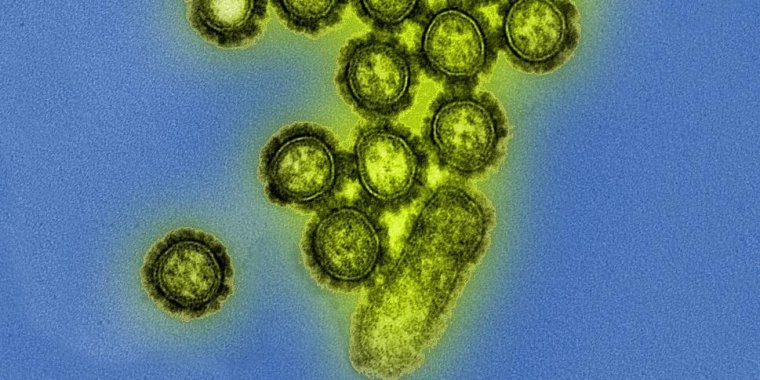| Health / Health News |
New study reveals a novel indicator of influenza immunity
A study of influenza virus transmission in Nicaraguan households reveals new insights into the type of immune responses that may be protective against influenza virus infection, report investigators. The findings could help scientists design more effective influenza vaccines and lead to the development of novel universal influenza vaccines.

Colorized transmission electron micrograph showing H1N1 influenza virus particles. Surface proteins on the virus particles are shown in black. Photo: NIAID
The study focused on antibodies produced against the “stem” of the mushroom-shaped influenza virus surface protein, hemagglutinin (HA). The HA stem is less variable than the HA head, the region targeted by current seasonal influenza vaccines and by standard laboratory tests used to gauge a person’s immune response to a particular strain of influenza.
The study team followed 88 people with confirmed pandemic H1N1 influenza A virus infection and 300 of their household contacts. For the latter group, the team measured pre-existing HA stem antibody levels with an enzyme-linked immunosorbent assay (ELISA) blood test and obtained additional blood samples 30 to 45 days later.
Investigators also obtained nasal and throat swabs from contacts at the start of the study and every few days for approximately two weeks thereafter to track whether they became infected with influenza virus. Eighty-four (28%) of the 300 household contacts eventually contracted laboratory-confirmed influenza virus infection, and 53 (63%) of those infected developed influenza symptoms.
Investigators found that people with higher levels of HA stem antibodies at the start of the study were less likely to become infected with influenza. The findings suggest that the level of HA stem antibodies can be used as an indicator, or correlate, of protection against influenza virus infection.
The study provides data to support the development of novel vaccine candidates targeting the HA stem, according to the researchers. Scientists hope such vaccine candidates will induce broader and more durable protection against influenza than current vaccines. The authors note that future studies should examine the role of HA stem antibodies for various strains of influenza virus. (National Institutes of Health)
YOU MAY ALSO LIKE



